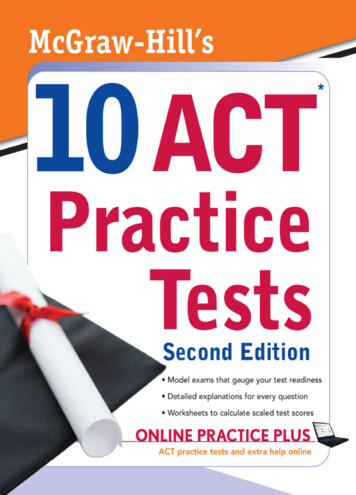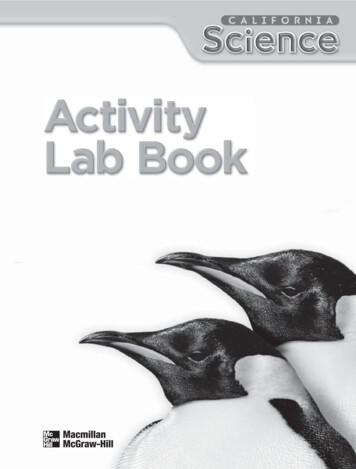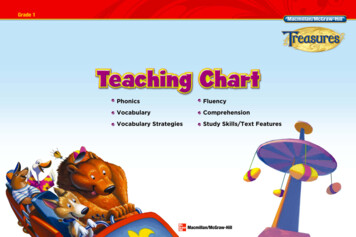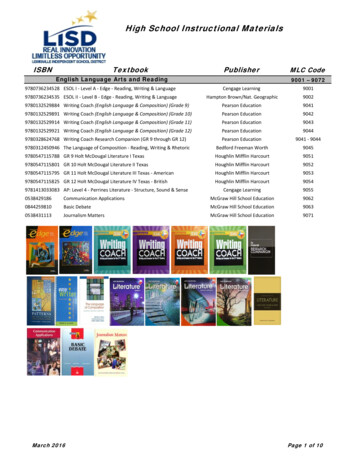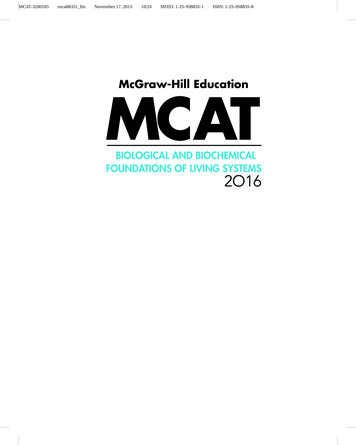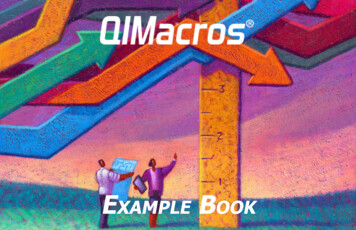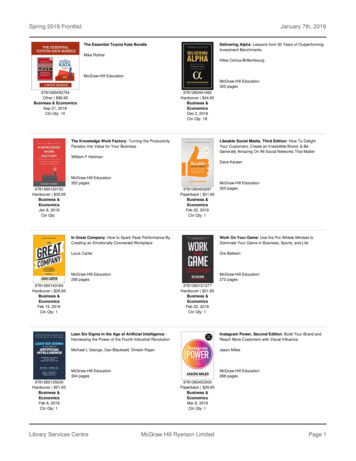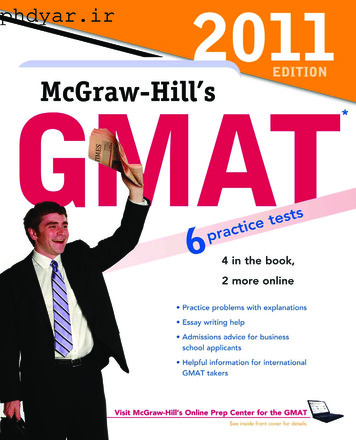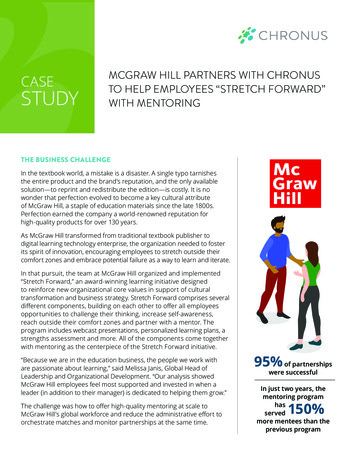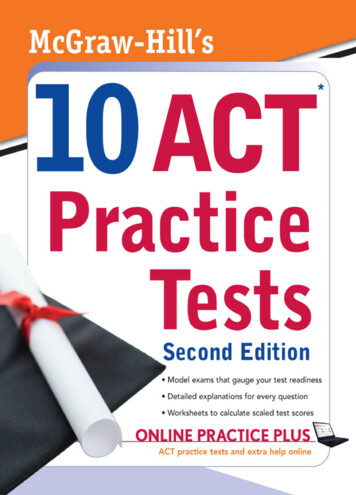
Transcription
McGraw-Hill’s10 ACT Practice Tests
ABOUT THE AUTHORSteve Dulan has been involved with the ACT since 1982, when he received ascore of 32 on his own test as a high school junior at Iron Mountain High School.That score qualified him for the State of Michigan Competitive Scholarship in1983. In 1989, after serving as a U.S. Army infantry Sergeant, and during histime as an undergraduate at Michigan State University, Steve became an ACTinstructor. He has been helping students to prepare for success on the ACT andother standardized exams ever since. Steve attended The Thomas M. CooleyLaw School on a full Honors Scholarship after achieving a 99th percentiIe scoreon his Law School Admission Test (LSAT). In fact, Steve scored in the 99thpercentile on every standardized test he has ever taken. While attending lawschool, Steve continued to teach standardized test prep classes (including ACT,SAT, PSAT, GRE, GMAT, and LSAT) an average of thirty hours each week, andtutored some of his fellow law students in a variety of subjects and in essay examwriting techniques. Steve has also served as an instructor at the college and lawschool levels.Thousands of students have benefited from Steve’s instruction, coaching, andadmissions consulting and have gone on to the colleges of their choice. Hisstudents have gained admission to some of the most prestigious institutions inthe world and received many scholarships of their own. A few of them evenbeat his ACT score! Since 1997, Steve has served as the President of AdvantageEducation (www.AdvantagEd.com), a company dedicated to providing effectiveand affordable test prep education in a variety of settings, including classesand seminars at high schools and colleges around the country, summer CollegePrep Camps at The University of Michigan, and one-on-one via the Internetworldwide.Copyright 2008 by The McGraw-Hill Companies, Inc. Click here for terms of use.
McGraw-Hill’s10 ACT Practice TestsSECOND EDITIONSteven W. Dulanand the faculty ofAdvantage EducationNew York Chicago San Francisco Lisbon London Madrid Mexico CityMilan New Delhi San Juan Seoul Singapore Sydney Toronto
Copyright 2008 by The McGraw-Hill Companies, Inc. All rights reserved. Manufactured in the United States of America. Except as permitted underthe United States Copyright Act of 1976, no part of this publication may be reproduced or distributed in any form or by any means, or stored in adatabase or retrieval system, without the prior written permission of the publisher.0-07-159147-8The material in this eBook also appears in the print version of this title: 0-07-159146-X.All trademarks are trademarks of their respective owners. Rather than put a trademark symbol after every occurrence of a trademarked name, we usenames in an editorial fashion only, and to the benefit of the trademark owner, with no intention of infringement of the trademark. Where suchdesignations appear in this book, they have been printed with initial caps.McGraw-Hill eBooks are available at special quantity discounts to use as premiums and sales promotions, or for use in corporate training programs.For more information, please contact George Hoare, Special Sales, at george hoare@mcgraw-hill.com or (212) 904-4069.TERMS OF USEThis is a copyrighted work and The McGraw-Hill Companies, Inc. (“McGraw-Hill”) and its licensors reserve all rights in and to the work. Use of thiswork is subject to these terms. Except as permitted under the Copyright Act of 1976 and the right to store and retrieve one copy of the work, you maynot decompile, disassemble, reverse engineer, reproduce, modify, create derivative works based upon, transmit, distribute, disseminate, sell, publish orsublicense the work or any part of it without McGraw-Hill’s prior consent. You may use the work for your own noncommercial and personal use; anyother use of the work is strictly prohibited. Your right to use the work may be terminated if you fail to comply with these terms.THE WORK IS PROVIDED “AS IS.” McGRAW-HILL AND ITS LICENSORS MAKE NO GUARANTEES OR WARRANTIES AS TO THEACCURACY, ADEQUACY OR COMPLETENESS OF OR RESULTS TO BE OBTAINED FROM USING THE WORK, INCLUDING ANYINFORMATION THAT CAN BE ACCESSED THROUGH THE WORK VIA HYPERLINK OR OTHERWISE, AND EXPRESSLY DISCLAIM ANYWARRANTY, EXPRESS OR IMPLIED, INCLUDING BUT NOT LIMITED TO IMPLIED WARRANTIES OF MERCHANTABILITY OR FITNESS FOR A PARTICULAR PURPOSE. McGraw-Hill and its licensors do not warrant or guarantee that the functions contained in the work willmeet your requirements or that its operation will be uninterrupted or error free. Neither McGraw-Hill nor its licensors shall be liable to you or anyoneelse for any inaccuracy, error or omission, regardless of cause, in the work or for any damages resulting therefrom. McGraw-Hill has no responsibility for the content of any information accessed through the work. Under no circumstances shall McGraw-Hill and/or its licensors be liable for anyindirect, incidental, special, punitive, consequential or similar damages that result from the use of or inability to use the work, even if any of them hasbeen advised of the possibility of such damages. This limitation of liability shall apply to any claim or cause whatsoever whether such claim or causearises in contract, tort or otherwise.DOI: 10.1036/007159146X
ProfessionalWant to learn more?We hope you enjoy thisMcGraw-Hill eBook! Ifyou’d like more information about this book,its author, or related books and websites,please click here.
For more information about this title, click hereCONTENTSAcknowledgmentsviiIntroduction: Using This BookHow to Use the Practice TestsA Note on Scoring the Practice TestsixixixUNDERSTANDING THE ACT1What Is the ACT?Who Writes the ACT?Registering for the ACTWhy Do ACT Exams Exist?ACT ScoresWriting Test Scoring GuidelinesPRACTICE TEST 1Answer KeyScoring GuideAnswers and ExplanationsPRACTICE TEST 2Answer KeyScoring GuideAnswers and ExplanationsPRACTICE TEST 3Answer KeyScoring GuideAnswers and ExplanationsPRACTICE TEST 4Answer KeyScoring GuideAnswers and ExplanationsPRACTICE TEST 5Answer KeyScoring GuideAnswers and 7309313317339394397401
viCONTENTSPRACTICE TEST 6Answer KeyScoring GuideAnswers and ExplanationsPRACTICE TEST 7Answer KeyScoring GuideAnswers and ExplanationsPRACTICE TEST 8Answer KeyScoring GuideAnswers and ExplanationsPRACTICE TEST 9Answer KeyScoring GuideAnswers and ExplanationsPRACTICE TEST 10Answer KeyScoring GuideAnswers and 3739743747769822825829
ACKNOWLEDGMENTSThe author would like to acknowledge the contribution of the faculty and staffof Advantage Education. You are not only the smartest, but also the best.Special thanks to Lisa DiLiberti, Amy Dulan, Matt Mathison, Kathy Matteo,Blair Morley, Ryan Particka, Andrew Sanford, Kim So, and Amanda Thompson.All of you put in extra effort to make this book a success.Copyright 2008 by The McGraw-Hill Companies, Inc. Click here for terms of use.
This page intentionally left blank
INTRODUCTION: USING THIS BOOKThis book contains ten simulated ACT practice tests. You can use these tests as“dress rehearsals” to get you ready for the whole experience of taking an ACTexam.If you have enough time between now and your ACT (at least three weeksbut preferably twelve to eighteen weeks), you should work through this entirebook. If you have only a few days, try to complete as many practice tests as timeallows. Even just a few hours of study and practice can have a beneficial impacton your ACT score.Use this book as a companion to McGraw-Hill’s ACT prep book.HOW TO USE THE PRACTICE TESTSEach practice test in this book is a full-length simulated ACT. Written by ACTexperts, these tests are designed to be as close as you can get to the actualexam. The tests contain some variations in style and mix of question type. Thisapproach is intentional so that you can get a taste of all of the various formats andstyles that can appear on an ACT exam. If you work through all of the materialprovided, you can rest assured that there won’t be any surprises on test day.However, you should keep your score results in perspective. Generally, studentstend to score slightly higher on each successive practice test. But the truth isthat ACT exams are sensitive to factors such as fatigue and stress. The time ofthe day that you take the exams, your surroundings, and other things going onin your life can have an impact on your scores. Don’t get worried if you see somevariations due to an off day or because the practice test exposed a weakness inyour knowledge base or skill set. Just use the information that you gather as atool to help you improve.There is an explanation for each of the practice questions in this book. Youwill probably not need to read absolutely all of them. Sometimes you can tellright away why you got a particular question wrong. We have seen countlessstudents smack themselves on the forehead and say “stupid mistake.” We try torefer to these errors as “concentration errors.” Everyone makes them from timeto time, and you should not worry when they occur. There is a good chancethat your focus will be a little better on the real test as long as you train yourself properly with the aid of this book. You should distinguish between thoseconcentration errors and any understanding issues or holes in your knowledgebase. If you have the time, it is worth reading the explanations for any of thequestions that were at all challenging for you. Sometimes, students get questionscorrect but for the wrong reason, or because they guessed correctly. While youare practicing, you should mark any questions that you want to revisit and besure to read the explanations for those questions.A NOTE ON SCORING THE PRACTICE TESTSThe tests in this book are simulations created by experts to replicate the question types, difficulty level, and content areas that you will find on your realACT. The Scoring Worksheets provided for each test are guides to computingCopyright 2008 by The McGraw-Hill Companies, Inc. Click here for terms of use.
xINTRODUCTION: USING THIS BOOKapproximate scores. Actual ACT exams are scored from tables that are unique toeach test. The actual scaled scores depend on a number of factors, which includethe number of students who take the test, the difficulty level of the items, (questions and answer choices), and the performance of all of the students who takethe test. This means that “your mileage may vary.” Do not get too hung up onyour test scores; the idea is to learn something from each practice experienceand to get used to the “look and feel” of the ACT.Each Scoring Worksheet has formulas for you to work out an approximatescaled score for each section, as well as an overall Composite Score. Each computation includes a “correction factor,” which is an average correction derivedfrom analysis of recent ACT exams. The correction factor is most valid for students whose scores are in the middle 50% of all scores. The correction factorstarts to lose a bit of its effectiveness at the top and bottom of the scoring scale.This is not a major flaw in the practice tests; your actual ACT score report willinclude a “band” around each score. ACT, Inc., says right on the student’s scorereport that they do this to highlight the fact that all test scores are just estimates.
UNDERSTANDING THE ACTWHAT IS THE ACT?The authors of the ACT insist that the ACT is an achievement test, meaning thatit is designed to measure your readiness for college instruction. There is ongoingdebate about how well the ACT accomplishes that mission. What is not debatedis that the ACT is not a direct measure of intelligence. It is not an IQ test. TheACT is certainly not a measure of your worth as a human being. It is not even aperfect measure of how well you will do in college. Theoretically, each of us hasa specific potential to learn and acquire skills. The ACT doesn’t measure yournatural, inborn ability. If it did, we wouldn’t be as successful as we are at raisingstudents’ scores on ACT exams.The ACT actually measures a certain knowledge base and skill set. It is“trainable,” meaning that you can do better on your ACT if you work on gainingthe knowledge and acquiring the skills that are tested.The ACT is broken up into four multiple-choice tests and one optional essay.The multiple-choice tests are called English, Mathematics, Reading, and ScienceReasoning, respectively. They are always given in the same order. In fact, thereis a lot of predictability when it comes to the ACT. The current exam still hasvery much in common with ACT exams from past years. This means that webasically know what is going to be on your ACT in terms of question types andcontent. The ACT Structure chart on the next page provides more informationon the format of the ACT.ACT offers a thirty-minute Writing Test as an optional component to theACT. Many colleges and universities require applicants to take the Writing Test.Be sure to check with your schools of choice prior to registering for the test.WHO WRITES THE ACT?There is a company called ACT, Inc. that decides exactly what is going to be onyour ACT exam. This group of experts consults with classroom teachers at thehigh school and college level. They look at high school and college curricula andthey employ educators and specialized psychologists called “psychometricians”(measurers of the mind), who know a lot about the human brain and how itoperates under various conditions. We picture them as “evil genius” researchersgleefully rubbing their hands together and trying to think up ways to keep youout of college. Don’t fear, however; we are the “good geniuses” trying to get youinto the college of your choice. We’ll lay out the details of how you will be testedso that you can get yourself ready for the “contest” on test day.REGISTERING FOR THE ACTYou must register for the ACT in advance. You can’t just show up on test daywith a number 2 pencil and dive right in. The best source of information for allthings ACT is, not surprisingly, the ACT Web site: www.act.org. There is alsoa very good chance that a guidance counselor and/or pre-college counselor atCopyright 2008 by The McGraw-Hill Companies, Inc. Click here for terms of use.
2UNDERSTANDING THE ACTACT StructureEnglish75 Questions45 MinutesContent/SkillsNumber of ge12Sentence Structure18Rhetorical 60 Questions60 MinutesContentNumber of QuestionsPre-Algebra and Elementary Algebra24Intermediate Algebra and Coordinate Geometry18Plane Geometry14Trigonometry4Reading40 Questions35 MinutesPassage TypeNumber of QuestionsProse Fiction10Social Science10Humanities10Natural Science10Science Reasoning40 Questions35 MinutesFormatNumber of QuestionsData Representation - 3 passages15Research Summaries - 3 passages18Conflicting Viewpoints - 1 passage7Content Areas: Biology, Physical Sciences, Chemistry, PhysicsThe ACT includes an optional 30-minute Writing Test, which comes after the Science Reasoning Test.
UNDERSTANDING THE ACT3your school has an ACT Registration Book, which includes all of the informationthat you need for your test registration.WHY DO ACT EXAMS EXIST?Back in the mid-twentieth century, some people noticed that there was a disturbing trend in college admissions. Most of the people who were entering collegecame from a fairly small group of people who went to a limited number of highschools. Many had parents who had attended the same colleges. There wasn’tmuch opportunity for students from new families to “break into” the higher education system. Standardized entrance exams were an attempt to democratize thesituation and create a meritocracy where admissions decisions were based onachievement and not just social status. The ACT was not the first standardizedcollege entrance exam. It came a little later as an attempt at improving on theolder SAT.Colleges use the ACT for admissions decisions and, sometimes, for advancedplacement. It is also used to make scholarship decisions. Since there are variations among high schools around the country, the admissions departments atcolleges use the ACT, in part, to help provide a standard for comparison. Thereare studies that reveal a fair amount of “grade inflation” at some schools. So, colleges cannot simply rely upon grade point averages when evaluating academicperformance.ACT SCORESEach of the multiple-choice sections of the ACT is called a Test. Each test isgiven a score on a scale of 1 to 36. These four “scaled scores” are then averagedand rounded according to normal rounding rules to yield a Composite Score. Itis this Composite Score that is most often meant when someone refers to yourACT score.Your actual score report will also refer to “subscores,” which are reportedfor your English, Mathematics, and Reading tests. These are based on yourperformance on a subset of the questions on each of these tests. Our experiencehas been that there is nothing to be gained from discussing them in detail withstudents. Reports indicate that many college admissions professionals don’t havethe faintest idea how to utilize them when making admissions decisions.One important thing that can be said about scores is that you don’t have tobe perfect to get a good score on the ACT. The truth is that you can miss a fairnumber of questions and still get a score that places you in the top 1% of all testtakers. In fact, this test is so hard and the time limit is so unrealistic for most testtakers that you can get a score that is at the national average (about a 21) even ifyou get almost half of the questions wrong. Use the scoring guidelines providedin this book to estimate your ACT score at each stage of your preparation.WRITING TEST SCORING GUIDELINESThe ACT Writing Test is scored on a 2-point through 12-point scale. Two professional, trained readers will evaluate your answer, and each of them will assign apoint value of 1 (worst) through 6 (best); the two scores are then totaled. If thetwo readers assign scores that differ by more than 1 point, then a 3rd reader willbe called in to read your essay and make the final decision regarding your score.The scores are holistic scores, which means that your essay is judged asa whole without assigning point values to the specific characteristics that the
4UNDERSTANDING THE ACTgraders are looking for. Use the following guidelines when scoring your essaysbased on the sample prompts included in this book.Score of 6: The essay takes a clear position and discusses other perspectives,including perspectives that may differ from the author’s. The essay is logical andcomplete. There are good transitions and very little or no irrelevant information.The introduction and conclusion are solid and consistent with each other andwith the argument. The essay predicts and deals with counter arguments. Whilethere may be a few errors, they are minor and infrequent. Grammar, spelling,and punctuation are nearly perfect. Vocabulary is effective and appropriate.Score of 5: The essay takes a clear position on the topic and might give anoverall context. The essay deals with some of the complex issues surrounding thetopic and at least raises some counter arguments. There are specific examplesgiven. Organization is clear and concise even if it is not creative. Transitionsignals are used. The author uses language competently and there is somevariation in word choice. Any errors present are relatively minor and notdistracting.Score of 4: The essay demonstrates an understanding of the issue and thepurpose of the essay is clear. The author states a position on the main issue and atleast raises some potential counter arguments. There is adequate developmentof ideas and some specific reasons and/or examples are given. There is somelogical sequence. Most transitions are simple. There is some variety in sentencelength and word choice. There are some distracting errors but the essay is stillunderstandable.Score of 3: The essay reveals that the author has some understanding ofthe task. There is a clear position but no real overall context is provided. Theremay be some mention of counter arguments but they are cursory or not clearlystated. The essay may be repetitious or redundant. The essay stays withinthe general subject but may stray from the specific issue. The organizationis simple and predictable. Transitions, if any, are simple and predictable.Introduction and conclusion are present but not well developed. Word choiceis generally appropriate and sentences lack variety in length or structure. Thereare distracting errors that impact understandability.Score of 2: The essay shows that the author misunderstood the assignment.There is no position taken on the main issue or there are no reasons given.There may be a general example or two but no specific examples offered. Thereare problems with the relevance of some of the statements made. Transitionwords may be incorrect or misleading. There are several distracting errors thataffect the understandability of the essay.Score of 1: The author demonstrates almost no grasp of the assignment.The essay fails to take a position or fails to support a position taken. May beexcessively redundant. There is little or no structure or coherence. There areseveral errors that nearly prevent understanding the author’s point, if any.Score of 0: The answer document is blank, the essay is on a topic of theauthor’s own choosing, the essay is either completely or nearly illegible, or theessay is not written in English.
PRACTICE TEST 1 ANSWER SHEET5ANSWER SHEETACT PRACTICE TEST 1Answer SheetENGLISH1234567891011121314151617181920 A F A F A F A F A F A F A F A F A F A F B C GH B C G H B C GH BC G H B C GH BC G H B C G H BC G H B C G H BC G H D J D J D J D J D J D J D J D J D J D JMATHEMATICS123456789101112131415 A F A F A F A F A F A F A F A B C G H BC G H B C G H BC GH B C G H BC GH B C G H B C D J D J D J D J D J D J D J D E K E K E K E K E K E K E K E 2122232425262728293031323334353637383940 A F A F A F A F A F A F A F A F A F A F B C GH B C G H B C GH BC G H B C GH BC G H B C G H BC G H B C G H BC G H D J D J D J D J D J D J D J D J D J D J 161718192021222324252627282930 F A F A F A F A F A F A F A F G H B C GH B C G H B C GH BC G H B C GH BC G H B C G H J D J D J D J D J D J D J D J K E K E K E K E K E K E K E K 4142434445464748495051525354555657585960 A F A F A F A F A F A F A F A F A F A F B C GH B C G H B C GH BC G H B C GH BC G H B C G H BC G H B C G H BC G H D J D J D J D J D J D J D J D J D J D J 313233343536373839404142434445 A F A F A F A F A F A F A F A B C G H BC G H B C G H BC GH B C G H BC GH B C G H B C D J D J D J D J D J D J D J D E K E K E K E K E K E K E K ECopyright 2008 by The McGraw-Hill Companies, Inc. Click here for terms of use. 616263646566676869707172737475 A F A F A F A F A F A F A F A B C GH B C G H B C GH BC G H B C GH BC G H B C G H B C D J D J D J D J D J D J D J D 464748495051525354555657585960 F A F A F A F A F A F A F A F G H B C GH B C G H B C GH BC G H B C GH BC G H B C G H J D J D J D J D J D J D J D J K E K E K E K E K E K E K E K
6PRACTICE TEST 1 ANSWER SHEETREADING12345678910 A F A F A F A F A F B C GH BC G H B C G H BC G H B C G HSCIENCE12345678910 A F A F A F A F A F B C G H B C G H BC G H B C G H BC G H D J D J D J D J D J 11121314151617181920 A F A F A F A F A F B C GH BC G H B C G H BC G H B C G H D J D J D J D J D J 21222324252627282930 A F A F A F A F A F B C GH BC G H B C G H BC G H B C G H D J D J D J D J D J 31323334353637383940 A F A F A F A F A F B C GH BC G H B C G H BC G H B C G H D J D J D J D J D J D J D J D J D J D J 11121314151617181920 A F A F A F A F A F B C G H B C G H BC G H B C G H BC G H D J D J D J D J D J 21222324252627282930 A F A F A F A F A F B C G H B C G H BC G H B C G H BC G H D J D J D J D J D J 31323334353637383940 A F A F A F A F A F B C G H B C G H BC G H B C G H BC G H D J D J D J D J D J RAW SCORESSCALE EADINGSCIENCESCIENCEDATE TAKEN:ENGLISH/WRITINGCOMPOSITE SCORERefer to the Scoring Worksheet on page 66 for help in determining your Raw and Scale Scores.
You may wish to remove these sample answer document pages to respond to the practice ACT Writing Test.Cut HereBegin WRITING TEST here.1If you need more space, please continue on the next page.Do not write in this shaded area.
WRITING TEST2If you need more space, please continue on the back of this page.Do not write in this shaded area.
Cut HereWRITING TEST3If you need more space, please continue on the next page.PLEASE DO NOT WRITE IN THIS AREA.
WRITING TEST4STOP here with the Writing Test.Do not write in this shaded area.
PRACTICE TEST 1 ENGLISH TEST111 1ENGLISH TEST45 Minutes—75 QuestionsDIRECTIONS: In the passages that follow, some wordsand phrases are underlined and numbered. In theanswer column, you will find alternatives for the wordsand phrases that are underlined. Choose the alternativethat you think is best, and fill in the correspondingbubble on your answer sheet. If you think that theoriginal version is best, choose “NO CHANGE,” whichwill always be either answer choice A or F. You willalso find questions about a particular section of thepassage, or about the entire passage. These questionswill be identified either by an underlined portion or bya number in a box. Look for the answer that clearlyexpresses the idea, is consistent with the style and toneof the passage, and makes the correct use of standardwritten English. Read the passage through once beforeanswering the questions. For some questions, youshould read beyond the indicated portion before youanswer.PASSAGE IHair-raising ProblemsWhy is it that we are so completely obsessive with the1hair on our heads? Millions of dollars are spent each yearon cutting hair, lengthening hair, bleaching hair,1. A.B.C.D.NO CHANGEobsessedobsessingobsessioned2. F.G.H.J.NO CHANGEpaypaying moneyhave paid3. A.B.C.D.NO CHANGEto haveto bebecoming for4. F.G.H.J.NO CHANGEhoweveryetand5. A.B.C.D.NO CHANGEresult forresult withresult bystraightening hair, curling hair, highlighting hair, and evengrowing hair; whatever you can do to hair, someone iswilling to pay the money to do it. Natural redheads long2for to be brunettes and dishwater blondes dream of shiny3golden tresses. Both men and women cringe at the sight ofeach gray hair, so teenagers enjoy weekly experiments4with magenta dyes, spikes, and tangerine streaks.All of these thoughts cross my mind as I examine theresult of my most recent hair adventure. As a mature5GO ON TO THE NEXT PAGE.
12PRACTICE TEST 1 ENGLISH TEST1 1woman watching the gray hairs mixing in rapidly with my6nat
Use this book as a companion to McGraw-Hill's ACT prep book. HOW TO USE THE PRACTICE TESTS Each practice test in this book is a full-length simulated ACT. Written by ACT experts, these tests are designed to be as close as you can get to the actual exam. The tests contain some variations in style and mix of question type. This
